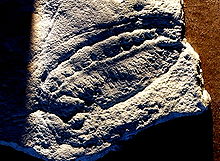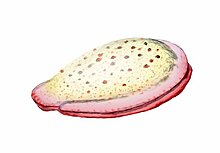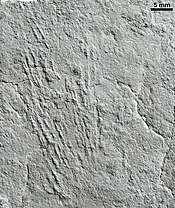Kimberella
| Kimberella Temporal range:Ediacaran,
| |
|---|---|

| |
| Remarkably preservedKimberellaatArkhangelsk Regional Museum,Russia. | |

| |
| Cast of a partialKimberellafossil. | |
| Scientific classification | |
| Domain: | Eukaryota |
| Kingdom: | Animalia |
| Clade: | Bilateria |
| Genus: | †Kimberella Wade,1972[1] |
| Type species | |
| †Kimberella quadrata Glaessner & Wade, 1966
| |
| Species | |
| Synonyms | |
Kimberellais an extinctgenusofbilaterianknown only from rocks of theEdiacaranperiod. The slug-like organism fed by scratching the microbial surface on which it dwelt in a manner similar to thegastropods,[2]although its affinity with this group is contentious.[3]
Specimens were first found in Australia'sEdiacara Hills,but recent research has concentrated on the numerous finds near theWhite SeainRussia,which cover an interval of time from555 to 558million years ago.[2]As with manyfossils from this time,its evolutionary relationships to other organisms are hotly debated. Paleontologists initially classifiedKimberellaas a type ofCubozoan,but, since 1997, features of its anatomy and its association with scratch marks resembling those made by aradulahave been interpreted as signs that it may have been amollusc.Although some paleontologists dispute its classification as a mollusc, it is generally accepted as being at least abilaterian.[4]
The classification ofKimberellais important for the scientific understanding of theCambrian explosion;if it was a mollusc, or at least aprotostome,this would mean that the two dominantNephrozoanlineages would have diverged significantly before555million years ago,and if it was at least bilaterian, its age would indicate thatanimalswere diversifying well before the start of theCambrian.[4]
Etymology
[edit]
The genus is named in honour of Mr. John Kimber, student, teacher, and collector; who lost his life during an expedition to Central Australia in 1964. Originally, the genus was given the nameKimberia,[5]however, the nameKimberiawas already in use as a subgenus ofTurritella(Gastropoda), according to Dr. N. H. Ludbrook; and a new genus,Kimberella,was proposed byMary Wadein 1972.[1]
Occurrence
[edit]Kimberellahas been found in theEdiacara HillsofSouth Australia,[6]in theUst' Pinega Formationin theWhite Searegion ofRussiaand the Kushk Series of central Iran.[7]The White Sea fossils are often associated with theEdiacaran "animals"TribrachidiumandDickinsonia,meanderingtrace fossiltrails, possibly made byKimberella;andalgae.Beds in the White Sea succession have been dated to555.3± 0.3 million years agoand558million years agobyradiometric dating,using uranium-lead ratios inzirconsfound in volcanic ash layers that are sandwiched between layers that containKimberellafossils.[8]Kimberellafossils are also known from beds both older and younger than this precisely dated range.[2]The fossils from the Ediacara Hills have not been dated precisely.[citation needed]
Description
[edit]
Over 1,000 specimens, representing organisms of all stages of maturity, have now been found in theWhite Seaarea at the bottom of fine-grained sandstone layers.[2][11]The large number of specimens, the small grain-size of the sediments and the variety of circumstances in which specimens were preserved provide detailed information aboutKimberella's external form, internal anatomy, locomotion and feeding style.[2]


All of the fossils are oval in outline. Elongated specimens illustrate that the organism was capable of stretching in an anterior-posterior direction,[11]perhaps by as much as a factor of two. Like many other specimens found in the White Sea, the most common type ofsymmetryobserved appears to be bilateral; with little to no sign of any of the kinds of radial symmetry found inCnidarians,the group that includesjellyfish,sea anemonesandhydras.The Australian fossils were originally described as a type of jellyfish, but this is inconsistent with the bilateral symmetry observed in the fossils. The White Sea fossils and the surrounding sediments also show thatKimberellalived on thesurface of the sea-floor.[9]
Kimberellahad adorsalcoveringthat has been described as a (non-mineralized) "soft shell"; in larger specimens, this reached up to 15 cm in length, 5–7 cm in width, and 3–4 cm in height;[12]with a minimum length of 2–3 mm.[2]
The shell was stiff but flexible, and appears to not have beenmineralized,becoming tougher as it grew larger (and presumably thicker) in more mature specimens.[2]The deformation observed in elongated and folded specimens illustrates that the shell was highly malleable; perhaps, rather than a singleintegument,it consisted of an aggregation of mineralised sclerites.[11]At the highest point was a hood-like structure, forming what is thought to be the front.[9][12]In some specimens, the inner surface of the shell bears stripes spanning the width of the creature; these may represent points of muscle attachment.[2]Similar stripes around the edge of the shell may have been connected to muscles that retracted the foot into the shell.[2]
The long axis of the organism is marked by a raised ridge; the middle axis is slightly humped. Kimberella's body had no visiblesegmentationbut had a series of repeated "modules".Each module included a well-developed band of dorso-ventral muscles running from the top to the single, broad, muscular" foot ", and smaller, transverse ventral muscles laterally across the underside of the body. The combination of these dorso-ventral and transverse ventral muscle bands enabled Kimberella to move by rippling its foot.[9][12]
The body also had a frilled fringe that may have been part of the animal's respiratory system, performing a function similar to that ofgills.The fact that the fringe extended well beyond the shell may indicate thatKimberella's "gills" were inefficient and needed a large area, or that there were no effective predators onKimberellaand the shell's main function was to provide a platform for the muscles.[12]
Ecology
[edit]Kimberelladwelt in shallow waters (up to tens of meters in depth), sharing the calm, well-oxygenated sea floor withphotosyntheticorganisms andmicrobial mats.[2]Assemblages bearingKimberellaoften also bear fossils ofAndiva,Yorgia,Dickinsonia,TribrachidiumandCharniodiscus,suggesting that it lived alongside these organisms.[2]
Kimberellaprobably grazed on microbial mats, but a selective predatory habit cannot be ruled out.[2]Fossilized gut content seems to confirm it was grazing on bentic bacteria and algae, the latter having gone through their own ecological "big bang" 650 million years ago in the marine ecosystem, providing a more nutrient rich diet for early animals.[13][14]Fedonkin reckons that as it ate, it moved "backwards"; the trail thus created was destroyed by the subsequent grazing activity.[2]Conversely, Gehling et al. claim that it moved 'forwards'.[15]Fans of grooves are often found radiating from the "head" end of the organism; these indicate that the organism stayed in one place, and raked the surface of the microbial mat towards it by extension of its head, which bore two "teeth".[11]Gehlinget al.reconstructKimberellaas having a long neck that operated like the arm of a digger, rotating about an axis perpendicular to the sea floor in order to produce the sweep of the fan, and rotating towards and away from the animal to scrape food from the substrate to the mouth. In one communityKimberellahas been shown to be avoiding its grazing traces, demonstrating complex sensory behaviour.[16]
The lack of evidence of asexual reproduction suggests that the organisms reproduced sexually. Budding or fission has never been observed.[2]
The waters in whichKimberelladwelt were occasionally disturbed bysandy currents,caused when sediments were whipped up by storms ormeltwaterdischarge, and washed over the creatures. In response to this stress, the organisms appear to have retracted their soft parts into their shells; apparently they could not move fast enough to outrun the currents.[2]Some organisms survived the current, and attempted to burrow out of the sand that had been deposited above them; some unsuccessful attempts can be seen where juveniles were fossilised at the end of a burrow a few centimetres long.[2]
Preservation
[edit]
Kimberellafossils are generally preserved on top of clay-rich beds and beneath sandy beds.[11]All fossils are preserved as depressions in the bases of beds, implying that the organism, although not mineralised, was firm enough to resist being crushed as sediment accumulated above it; as the soft parts of the organism decayed, the soft muds underneath would be squeezed up into the shell, preserving the shape of the organism.[2]
Preservation of most specimens was made possible by the fast sedimentation that quickly cut the organism off from seawater; it may also have been enhanced by the decay products of the rotting organism, which could have helped the overlying sediment to mineralise and harden.[2]It has been suggested that amucustrail produced by the organism may have assisted its preservation,[2]but experiments suggest that mucus disintegrates too easily to play a role in binding sediment together.[17]
Classification
[edit]
All theKimberellafossils found so far are assigned to onespecies,K. quadrata.The first specimens were discovered in Australia in 1959. They were originally classified asjellyfishbyMartin GlaessnerandMary Wadein 1966,[5]and then asbox jellyfishby Wade in 1972,[1]a view that remained popular until the fossils of the White sea region were discovered; these prompted a reinterpretation.[2]Research on these specimens byMikhail A. Fedonkin,initially with Benjamin M. Waggoner in 1997,[9]led toKimberellabeing recognised as the oldest well-documentedtriploblasticbilaterianorganism — not a jellyfish at all.[19]
So far,Kimberellafossils show no sign of aradula,the toothedchitinous"tongue" that is the diagnostic feature of modernmolluscs,excludingbivalves.Since radulae are very rarely preserved in fossil molluscs, its absence does not necessarily mean thatK. quadratadid not have one. The rocks in the immediate vicinity ofKimberellafossils bear scratch marks that have been compared to those made by the radulae of molluscs as they graze onmicrobial mats.Thesetraces,namedRadulichnusandKimberichnus,have been interpreted as circumstantial evidence for the presence of a radula. In conjunction with the univalve shell, this has been taken to indicateKimberellawas a mollusc or very closely related to molluscs.[9]In 2001 and 2007, Fedonkin suggested that the feeding mechanism might be a retractableprobosciswith hook-like organs at its end.[12]Kimberella's feeding apparatus appears to differ significantly from the typical mollusc radula, and this demonstrates thatKimberellais at best a stem-group mollusc.[20]Notably, the scratch marks indicate that the 'teeth' were dragged towards the organism, not pushed away as in molluscs, and that the maximum impact on the sediment was when the mouthpart was furthest from the organism.[21]The direction of grazing is also backwards, as opposed to forwards as in molluscs.[21]Furthermore, the constant width of grooves implies stereoglossy – a trait that is very derived in molluscs.[22]It has been argued that the shape of the feeding traces is incompatible with a radula, and that despite the molluscan body form, the lack of a radula placesKimberellawell outside the molluscan crown group.[11]Butterfield points out that plenty of other groups of organisms bear structures capable of making similar marks.[4][23]
Taken together, sceptics doubt that the available evidence is enough to reliably identifyKimberellaas a mollusc or near-mollusc, and suggest that it is presumptuous to call it anything more than a "possible" mollusc,[8]or even just a "probable bilaterian".[4]
Theoretical importance
[edit]| Part of a series on |
| TheCambrian explosion |
|---|
 |
TheCambrian explosionis an apparently rapid increase in the variety of basic body structures of animals in the EarlyCambrianperiod, starting after543million years agoand finishing before518million years ago.[24]A few of the Early Cambrian fossils were already known in the mid-19th century, andCharles Darwinsaw the apparently sudden appearance anddiversificationofanimalsas one of the main objections that could be made against his theory of evolution bynatural selection.[25]
The majority of animals more complex thanjellyfishand other cnidarians are split into two groups, theprotostomesanddeuterostomes.[19]The mollusc-like features ofKimberellastrongly suggest that it was a member of the protostomes.[9][12]If so, this means that the protostome and deuterostome lineages must have split some time beforeKimberellaappeared — at least558million years ago,and hence well before the start of the Cambrian538.8million years ago.Even if it is not a protostome, it is widely accepted as a member of the more inclusivebilaterianclade.[19][4]Since fossils of rather modern-looking cnidarians have been found in theDoushantuolagerstätte,the cnidarian and bilaterian lineages would have diverged well over580million years ago.[19]
See also
[edit]References
[edit]- ^abcdWade, M. (1972)."Hydrozoa and Scyphozoa and other medusoids from the Precambrian Ediacara fauna, South Australia"(PDF).Palaeontology.15:197–225. Archived fromthe original(PDF)on 2011-04-09.
- ^abcdefghijklmnopqrstuFedonkin, M.A.; Simonetta, A; Ivantsov, A.Y. (2007), "New data onKimberella,the Vendian mollusc-like organism (White sea region, Russia): palaeoecological and evolutionary implications ", in Vickers-Rich, Patricia; Komarower, Patricia (eds.),The Rise and Fall of the Ediacaran Biota,Special publications, vol. 286, London: Geological Society, pp. 157–179,doi:10.1144/SP286.12,ISBN978-1-86239-233-5,OCLC156823511
- ^Nelson R Cabej (2019).Epigenetic Mechanisms of the Cambrian Explosion.Elsevier Science. p. 152.ISBN9780128143124.
- ^abcdeButterfield, N.J. (2006). "Hooking some stem-group" worms ": fossil lophotrochozoans in the Burgess Shale".BioEssays.28(12): 1161–6.doi:10.1002/bies.20507.PMID17120226.S2CID29130876.
- ^abGlaessner, M.F.; Wade, M. (1966)."The late Precambrian fossils from Ediacara, South Australia"(Free full text).Palaeontology.9(4): 599.
- ^Glaessner, M.; Daily, B. (1959)."The Geology and Late Precambrian Fauna of the Ediacara Fossil Reserve"(PDF).Records of the South Australian Museum.13:369–401.Retrieved2008-07-16.
- ^Vaziri, Seyed Hamid; Majidifard, Mahmoud Reza; Laflamme, Marc (2018-03-22)."Diverse Assemblage of Ediacaran fossils from Central Iran".Scientific Reports.8(1): 5060.Bibcode:2018NatSR...8.5060V.doi:10.1038/s41598-018-23442-y.ISSN2045-2322.PMC5864923.PMID29567986.
- ^abMartin, M.W.; Grazhdankin, D.V.; Bowring, S.A.; Evans, D.A.D.; Fedonkin, M.A.; Kirschvink, J.L. (2000-05-05). "Age of Neoproterozoic Bilaterian Body and Trace Fossils, White Sea, Russia: Implications for Metazoan Evolution".Science(abstract).288(5467): 841–5.Bibcode:2000Sci...288..841M.doi:10.1126/science.288.5467.841.PMID10797002.S2CID1019572.
- ^abcdefgFedonkin, M. A.; Waggoner, B. M. (1997)."The Late Precambrian fossilKimberellais a mollusc-like bilaterian organism ".Nature.388(6645): 868–871.Bibcode:1997Natur.388..868F.doi:10.1038/42242.S2CID4395089.
- ^Jenkins, R.J.F. (1992). "Functional and ecological aspects of Ediacaran assemblages". In Lipps, J.; Signor, P.W. (eds.).Origin and Early Evolution of the Metazoa.New York, NY: Springer. pp. 131–176.ISBN0-306-44067-9.
- ^abcdefgIvantsov, A.Y. (2009). "A new reconstruction ofKimberella,a problematic Vendian Metazoan ".Paleontological Journal.43(6): 601–611.doi:10.1134/S003103010906001X.S2CID85676210.
- ^abcdefFedonkin, M.A.; Simonetta, A.; Ivantsov, A.Y. (2007)."New data on Kimberella, the Vendian mollusc-like organism (White Sea region, Russia): Palaeoecological and evolutionary implications"(PDF).Geological Society, London, Special Publications.Special Publications.286(1). London, UK: Geological Society: 157–179.Bibcode:2007GSLSP.286..157F.doi:10.1144/SP286.12.S2CID331187.Archived fromthe original(PDF)on 2008-07-21.Retrieved2008-07-10.
- ^World's oldest meal helps unravel mystery of our earliest animal ancestors
- ^"The algae that terraformed Earth".BBC News.Archivedfrom the original on 2023-07-13.
- ^Gehling, J. G.; Runnegar, B. N.; Droser, M. L. (2014). "Scratch Traces of Large Ediacara Bilaterian Animals".Journal of Paleontology.88(2): 284–298.doi:10.1666/13-054.S2CID140559034.
- ^Mitchell, E. G.; Bobkov, N.; Dhungana, A.; Kolesnikov, A. V.; Hogarth, I. R. P.; Liu, A. G.; Mustill, T. M. R.; Sozonov, N.; Rogov, S.; Xiao, V. I.; Grazhdankin, D. V. (2020)."The influence of environmental setting on the community ecology of Ediacaran organisms".Interface Focus.10(4).doi:10.1098/rsfs.2019.0109.PMC7333898.PMID32642052.
- ^Getty, P.R. (2006)."Producing And PreservingClimactichnites".Geological Society of America Abstracts with Programs.38(7): 475. Archived fromthe originalon 2012-02-11.Retrieved2008-06-02.
- ^Andrey Yu. Ivantsov (2013)."Trace Fossils of Precambrian Metazoans" Vendobionta "and" Mollusks "".Stratigraphy and Geological Correlation.21(3): 252–264.Bibcode:2013SGC....21..252I.doi:10.1134/S0869593813030039.S2CID128638405.
- ^abcdErwin, Douglas H.; Eric H. Davidson (1 July 2002)."The last common bilaterian ancestor".Development.129(13): 3021–3032.doi:10.1242/dev.129.13.3021.PMID12070079.
- ^Andrey Yu. Ivantsov (2010). "Paleontological evidence for the supposed precambrian occurrence of mollusks".Paleontological Journal.40(12): 1552–1559.doi:10.1134/S0031030110120105.S2CID86523806.
- ^abIvantsov, A. Y. (2013). "Trace fossils of precambrian metazoans" Vendobionta "and" Mollusks "".Stratigraphy and Geological Correlation.21(3): 252–264.Bibcode:2013SGC....21..252I.doi:10.1134/S0869593813030039.S2CID128638405.
- ^Smith, M. R. (2012)."Mouthparts of the Burgess Shale fossilsOdontogriphusandWiwaxia:Implications for the ancestral molluscan radula ".Proceedings of the Royal Society B.279(1745): 4287–4295.doi:10.1098/rspb.2012.1577.PMC3441091.PMID22915671.
- ^Butterfield, N. J. (2008). "An Early Cambrian Radula".Journal of Paleontology.82(3): 543–554.doi:10.1666/07-066.1.S2CID86083492.
- ^Cowen, R. (2000).History of Life(3rd ed.). Blackwell Science. p. 63.ISBN0-632-04444-6.
- ^Darwin, C(1859).On the Origin of Species by Natural Selection.Murray, London, United Kingdom. pp. 315–316.
